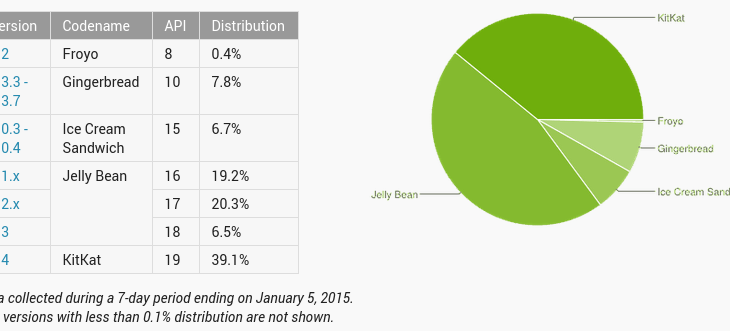
A new year, a new bunch of numbers, and as we saw last month there’s still no sign of Lollipop, despite being released for 2 months now. The data they’ve released has been collected during the 7 days leading up to January 5th, so how does it look?
Well, FroYo continues to decline, dropping 0.1% from last month, Gingerbread (the OS version that will never die) has dropped a pretty big 1.3%, while Ice Cream Sandwich dropped almost as much at 1.1%, down to 6.7%. Jelly Bean iterations saw decline across the 4.1 to 4.3 versions. KitKat has gained share, making up almost 40% of devices accessing Google Play but there’s still no sign of the latest entrant to hit the market.
For your convenience, here’s the comparison from last time.
| Android Version | November | December |
| Android 2.2 (Froyo) | 0.5% | 0.4% |
| Android 2.3.3 – 2.3.7 (Gingerbread) | 9.1% | 7.8% |
| Android 4.0.3 – 4.0.4 (Ice Cream Sandwich) | 7.8% | 6.7% |
| Android 4.1.x (JellyBean) | 21.3% | 19.2% |
| Android 4.2.x (JellyBean) | 20.4% | 20.3% |
| Android 4.3 (JellyBean) | 7.0% | 6.5% |
| Android 4.4 (KitKat) | 33.9% | 39.1% |
Source: Android Developer Console.





I think this says more about their survey methodology than it does about the penetration of 5.x
We know that basically all Nexus 5, 7, 10, as well as the 6 and 9, have had Lollipop installed OTA by now. That amounts to a good few percent in itself, plus the other phones/tablets with it. If they aren’t seeing it in the console numbers, then their methodology is somewhat suspect.
Hell, they should have been seeing the preview version for months now. That was installed on more than 1 in a thousand devices.
All Nexus 7’s except my N7 (2012 3G) which is *still* waiting for the OTA Lollipop update. Very frustrating, since the main reason I purchased a Nexus was to get rapid updates. Now I am seeing non-Nexus devices receive the update before my Nexus.
I just don’t understand why it takes so long for OEMs to release their versions of 5.0. Is Google slow to release it to them or do their developers just take a long time ?
It’s a combination of things, Jamie. The size of the OS is only partly a factor. Some devices simply do not have enough on board storage for the OS. The bigger problem with OS footprint is all the manufacturer ‘customizations’ to the OS. Those bloat the OS a massive number of times. Then there’s the performance hit that these ‘customizations’ cause. Some devices simply cannot handle the new OS and ‘customizations’. It takes time to sort through that. And then, usually while the testing is being done, new bugfix point releases of Android show up, and it’s back to square… Read more »
Broken record much Jeni. Get over it, you forget what Android is, it is not iOS it is an open source OS for phones and other devices and as such a vendor creates a version for their phone and adds their features to make it unique. The device does not need the latest and greatest it just needs to work and work well, after a couple of years the devices are usually replaced so why worry about updating old devices and spending major $ on development for a device that hardly anyone cares about any more. Jeni despite what you… Read more »